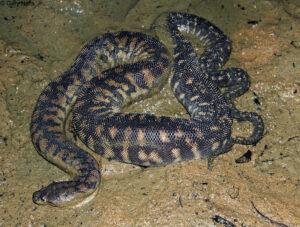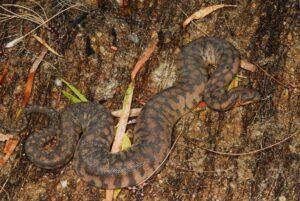The Acrochordus arafurae or the Arafura file snake is an aquatic snake native to the Australian continent, primarily found in the northern part of Australia and the island of New Guinea. The snake is known by several other names like the wrinkle file snake and elephant trunk snake.
The snake derives its name from its rough ridged skin, giving it a file-like texture that helps it to easily grip slippery big fish species like the eel-tailed catfish. American herpetologist Samuel Booker
McDowell, Jr. first described this species in 1979.
They still serve as an essential food source to the Aboriginal tribes of northern Australia. The older women of their community mainly hunt for these snakes by going deep into the water and searching in between the submerged logs. Once captured, the snakes are thrown into the bank while the hunting goes on for more snakes. Staying on land for long slows their movement, making it easy for the local people to catch them. Their skin is also used in making drums in New Guinea.
Scientific Classifications
- Family:Acrochordidae
- Genus:Acrochordus
- Species:Acrochordus arafurae
Conservation Status
Description
Size
Adult snakes grow to around 2.5 m and weigh about 11-12 lbs (5-5.5 kgs). The females are larger and heavier.
Color and Appearance
The file-like small but firmly keeled scales give their skin a loose, baggy, and rough texture. These snakes mostly have a light brown or gray body. Irregular black patches and bands run down from their head to the entire length of their body. This results in a cross-banded and blotchy appearance, mainly on the dorsal part. The undersides, marked with white scales, appear lighter than the upper body.
Subspecies and Morphs
The Arafura file snake has no recognized subspecies at present. Neither are there any noted color morphs of this snake.
Are they Dangerous
These are non-venomous snakes and are not considered dangerous. There have been no records of them biting humans to date.
Arafura File Snake at a Glance
Distribution
Northern Australia and New Guinea
Habitat
Dry season – Pools, backwater lagoons; Wet season – Flooded grasslands, mangroves
Lifespan
About 9 years in captivity
Predators
Crocodiles, birds of prey like falcons, hawks, and eagles
Diet
Mostly fish; they forage for their food at night, and prey selection depends on the snake’s size. In fact, larger species would prefer ingesting heavier fish weighing as much as 1kg. They have a low metabolic rate and feed only about once a month. Their small but solid teeth give them a proper grip over their prey which they entangle firmly using their coils, tail, and mouth.
Reproduction
Viviparous, giving birth to live young; with about 17 young snakes in a litter
Females reproduce every 8-10 years in the wild. Males can store the sperms inside their bodies for a prolonged period. Increased population density, lack of proper feeding, fluctuation in climatic conditions, and low metabolic rate are primarily responsible for the low reproduction rate.
Source
calphotos.berkeley.edu, californiaherps.com







